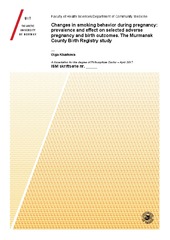Changes in smoking behavior during pregnancy: prevalence and effect on selected adverse pregnancy and birth outcomes. The Murmansk County Birth Registry study
Permanent link
https://hdl.handle.net/10037/12529View/
Thesis (PDF)
Paper 1: Kharkova, O. A., Krettek, A., Grjibovski, A. M., Nieboer, E., Odland, J. Ø. (2016). Prevalence of smoking before and during pregnancy and changes in this habit during pregnancy in Northwest Russia: a Murmansk county birth registry study. Also available in http://doi.org/10.1186/s12978-016-0144-x Reprod Health 13:18. (PDF)
Paper 2: Kharkova, O. A., Grjibovski, A. M., Krettek, A., Nieboer, E., Odland, J. Ø. (2017). First-trimester smoking cessation in pregnancy did not increase the risk of preeclampsia/eclampsia: A Murmansk County Birth Registry study. Also available in PLoS One, 12(8):e0179354. . (PDF)
Paper 3: Kharkova, O. A., Grjibovski, A. M., Krettek, A., Nieboer, E., Odland, J. Ø. (2017). Effect of Smoking Behavior before and during Pregnancy on Selected Birth Outcomes among Singleton Full-Term Pregnancy: A Murmansk County Birth Registry Study. Also available in Int J Environ Res Public Health, 14(8): E867. (PDF)
Date
2018-04-06Type
Doctoral thesisDoktorgradsavhandling
Author
Kharkova, Olga A.Abstract
Aims:
The specific objectives of this thesis were to i) determine the prevalence of smoking before and during pregnancy and to assess socio-demographic factors associated with discontinuing smoking or smoking reduction once pregnant; ii) investigate the effect of first-trimester smoking cessation while pregnant on Preeclampsia/eclampsia; and iii) explore the effect of changes in smoking behavior during pregnancy on selected adverse birth outcomes.
Methods:
This study was registry-based with data from Murmansk County Birth Registry (N = 52,806). Information about smoking before and during pregnancy was self-reported and assessed during the first antenatal visit.
Results:
Almost 25 % of women smoked before pregnancy, and 18.9 % of these continued smoking during pregnancy. One fourth of smoking women stopped to do it after pregnancy recognition and on third reduced the quantity of cigarettes smoked during pregnancy. Parity, level of education and marital status or maternal age and number of children were associated with giving up smoking or its reduction, respectively, during pregnancy. Maternal smoking was inversely associated with Preeclampsia/eclampsia. However, the women who quitted smoking during first-trimester of pregnancy had the same risk of this affliction as those who smoked while pregnant. Moreover, the pregnant women who stopped smoking during the first-trimester of gestation were at no greater risk of having a baby with adverse birth outcomes, namely, low values of birth weight, birth length, head circumference, ponderal index or Apgar score at 5 min. Interestingly, smoking reduction during pregnancy was not associated with a decrease in the adverse birth outcomes examined.
Conclusions:
While maternal smoking decrease the risk of Preeclampsia/eclampsia, but giving up smoking during first-trimester of gestation does not influence this pregnancy outcome. Moreover, compared to non-smokers, the women who quit smoking during the first-trimester are at no higher risk of having a newborn with adverse birth outcomes.
The specific objectives of this thesis were to i) determine the prevalence of smoking before and during pregnancy and to assess socio-demographic factors associated with discontinuing smoking or smoking reduction once pregnant; ii) investigate the effect of first-trimester smoking cessation while pregnant on Preeclampsia/eclampsia; and iii) explore the effect of changes in smoking behavior during pregnancy on selected adverse birth outcomes.
Methods:
This study was registry-based with data from Murmansk County Birth Registry (N = 52,806). Information about smoking before and during pregnancy was self-reported and assessed during the first antenatal visit.
Results:
Almost 25 % of women smoked before pregnancy, and 18.9 % of these continued smoking during pregnancy. One fourth of smoking women stopped to do it after pregnancy recognition and on third reduced the quantity of cigarettes smoked during pregnancy. Parity, level of education and marital status or maternal age and number of children were associated with giving up smoking or its reduction, respectively, during pregnancy. Maternal smoking was inversely associated with Preeclampsia/eclampsia. However, the women who quitted smoking during first-trimester of pregnancy had the same risk of this affliction as those who smoked while pregnant. Moreover, the pregnant women who stopped smoking during the first-trimester of gestation were at no greater risk of having a baby with adverse birth outcomes, namely, low values of birth weight, birth length, head circumference, ponderal index or Apgar score at 5 min. Interestingly, smoking reduction during pregnancy was not associated with a decrease in the adverse birth outcomes examined.
Conclusions:
While maternal smoking decrease the risk of Preeclampsia/eclampsia, but giving up smoking during first-trimester of gestation does not influence this pregnancy outcome. Moreover, compared to non-smokers, the women who quit smoking during the first-trimester are at no higher risk of having a newborn with adverse birth outcomes.
Publisher
UiT The Arctic University of NorwayUiT Norges arktiske universitet
Series
ISM skriftserie; 190Metadata
Show full item recordCollections
- Doktorgradsavhandlinger (Helsefak) [770]
- ISM skriftserie [161]
Copyright 2018 The Author(s)
The following license file are associated with this item:


 English
English norsk
norsk
